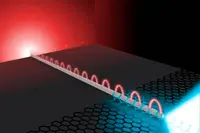 Researchers at the University of Rochester, New York have succeeded in shrinking photonic devices below the diffraction limit of visible light - around 200 to 300nm - a necessary step on the road to making photonic circuits competitive with today's technology. The scientists developed a nanoscale photodetector that uses molybdenum disulphide to detect optical plasmons and demonstrated that light can drive a current using a silver nanowire.
Researchers at the University of Rochester, New York have succeeded in shrinking photonic devices below the diffraction limit of visible light - around 200 to 300nm - a necessary step on the road to making photonic circuits competitive with today's technology. The scientists developed a nanoscale photodetector that uses molybdenum disulphide to detect optical plasmons and demonstrated that light can drive a current using a silver nanowire.
Kenneth Goodfellow, a graduate student in the laboratory of the Quantum Optoelectronics and Optical Metrology Group, said: "It is a step towards using light to drive, or, at least complement electronic circuitry for faster information transfer."
The device expands on previous work demonstrating that light could be transmitted along a silver nanowire as a plasmon and re-emitted at the other end, which was covered with atomically-thin flakes of molybdenum disulfide (MoS2). When re-emitted, the light corresponded to the band gap of MoS2, rather than solely to the laser's wavelength, demonstrating that the plasmons effectively nudged the electrons in MoS2 into a different energy state.
"The natural next idea would be to see if this type of device would be able to be used as a photodetector," Goodfellow said.
To do this, the group transferred a silver nanowire coated at one end with MoS2 onto a silicon substrate and deposited metal contacts onto that same end with electron beam lithography. They then connected the device to equipment to control its bias, or fixed, voltage and to measure the current running through it.
When the uncovered end of the wire was exposed to a laser, the energy was converted into plasmons. This energy electronically excited an electron once it reached the molybdenum disulphide-covered end, effectively generating a current.
"Full photonic circuits are some way off in the future, but this work helps to feed the current effort," Goodfellow said.
Future work for the group includes reducing potential contamination in device assembly by transitioning to a complete dry transfer of wires and MoS2 onto prefabricated electrodes, as well as gaining better control of the MoS2 doping process to add additional charge carriers and improve the device's efficiency.
Pic: This image shows light traveling along a silver nanowire as plasmons and re-emitted via molybdenum disulphide
Author
Tom Austin-Morgan
Source: www.newelectronics.co.uk

